The provierbial soviet self-propelled gun
It became as ubiquitous around the world as the T-54/55, but it was not a battle tank, although the public at large sees the same: Tracks, a turret and a big gun. Instead, this was the most produced self-propelled gun of the cold war, eclipsing all others, including NATO. It saw plenty of action to to its widespread use by 41 countries and operators sing its introduction in the 1970s and it's certainly not over. In Soviet nomenclature, 2S1 signified the second model S for self-propelled, its GRAU designation. Army designation was SAU-122, and "Gvozdika" meaning "Carnation", as more of a popular surname. This Soviet self-propelled howitzer had a long development history started in 1954. It entered service 15 years after, and mass-produced to became the main vehicle of the type in the Soviet Inventory and Warsaw Pact as well.Development
In 1945, the Great Patriotic War ended with Soviet Forces using lots of anti-tank and assault self-propelled guns. By that time, self-propelled artillery units (ACS) had to assume direct support of infantry and tanks, and direct fire at enemy targets in some cases. In Western countries self-propelled guns were designed for firing from closed positions and gradually, self-propelled artillery supplanted towed one. From 1947 to 1953, research was carried out to create new self-propelled howitzers. However by 1955, Khrushchev suspended these. Some time later, the USSR Ministry of Defense concluded that a strategic nuclear war was unlikely, and that local conflicts using tactical nuclear weapons was more probable. Therefore, self-propelled artillery had an undeniable advantage over towed artillery and studies were resumed.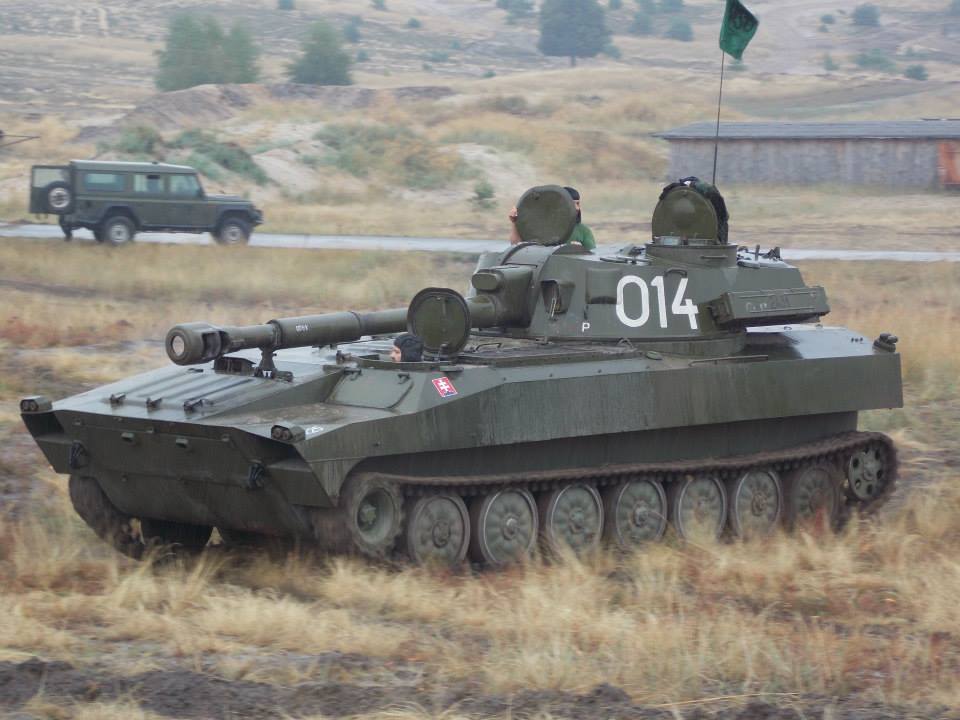
Slovakian 2S1
After Khrushchev resignation, and especially from 1965, tests were performed with SPGs, notably at Lviv training ground, when Soviet troops conducted large-scale exercises using WW2 artillery, and results shown how should be used self-propelled artillery in the context of modern combat. With the aim catching up with the West, in 1967 a resolution of the Central Committee of the CPSU and the Council of Ministers No. 609-201, of July 4 1967 was issued and confirmed the development of a new 122-mm self-propelled howitzer. VNII-100 previously since 1965 had released research work to determine the appearance and basic characteristics of the new vehicle, and three versions were worked out:
- Object 124 chassis SPG (also used for the SU-100P)
- MT-LB chassis basis
- BMP-1 IFV chassis version
Indeed, the Kharkiv Tractor Plant was appointed as lead developer plant for the the 2S1, and its onboard 2A31 howitzer (D-32), designed at OKB-9. In August 1969, the first four experimental 2S1 entered field trials. These tests revealed toxic level of gas backdraft in the fighting compartment. The same also happened on the 152-mm divisional self-propelled howitzer 2S3. Therefore modified versions of howitzers were developed for both SPGs. On the basis of the 2A31, a 122-mm D-16 howitzer with a capped loading system was developed. Instead of a wedge bolt, a chain rammer and classic charges, the D-16 used a piston bolt, a pneumatic rammer, and cartridge charges. Tests showed shortcomings with the new D-16 howitzer. Charge canisters proved problematic and there were designed flaws in the pneumatic rammer; As a result the rate of fire was no better than the field gun. Further improvement of the D-16 led to the creation of the D-16M showing an increase in the range to 18 km, with an enlarged chamber more powerful cap charges.
In 1971, the 3rd Central Research Institute reviewed and analyzed the results of 122-mm and 152-mm cartridges. Despite the results obtained, 3 TsNII concluded no further R&D was to be undertook on improving charges of the 2A31 howitzer. The main reason was the absence of a technical solution for reliable and safe charges in a hard cap in time and the scientific and technical groundwork was later applied to the new 122-mm high-explosive fragmentation projectile, with an improved aerodynamic shape. Using a more powerful ejector and improved obturation for the loading sleeve also solved the gas backdraft problem. In 1970, by decree of the Central Committee No. 770-249, September 14 1971, based on the latter modifications, the self-propelled artillery 2S1 was officially adopted by the Soviet army. In 1972, the 2S1 passed state tests and was put into service first with the 4P134 parachute platform (flight weight 20.5 tons) in order to validate its use wit the VDV. This platform used the PS-9404-63R with five parachute, planned to drop the 2S1 and this went through a full cycle of tests but never entered service with the Airborne as the lighter 2S2 "Violet" was developed already.
Design of the 2S1
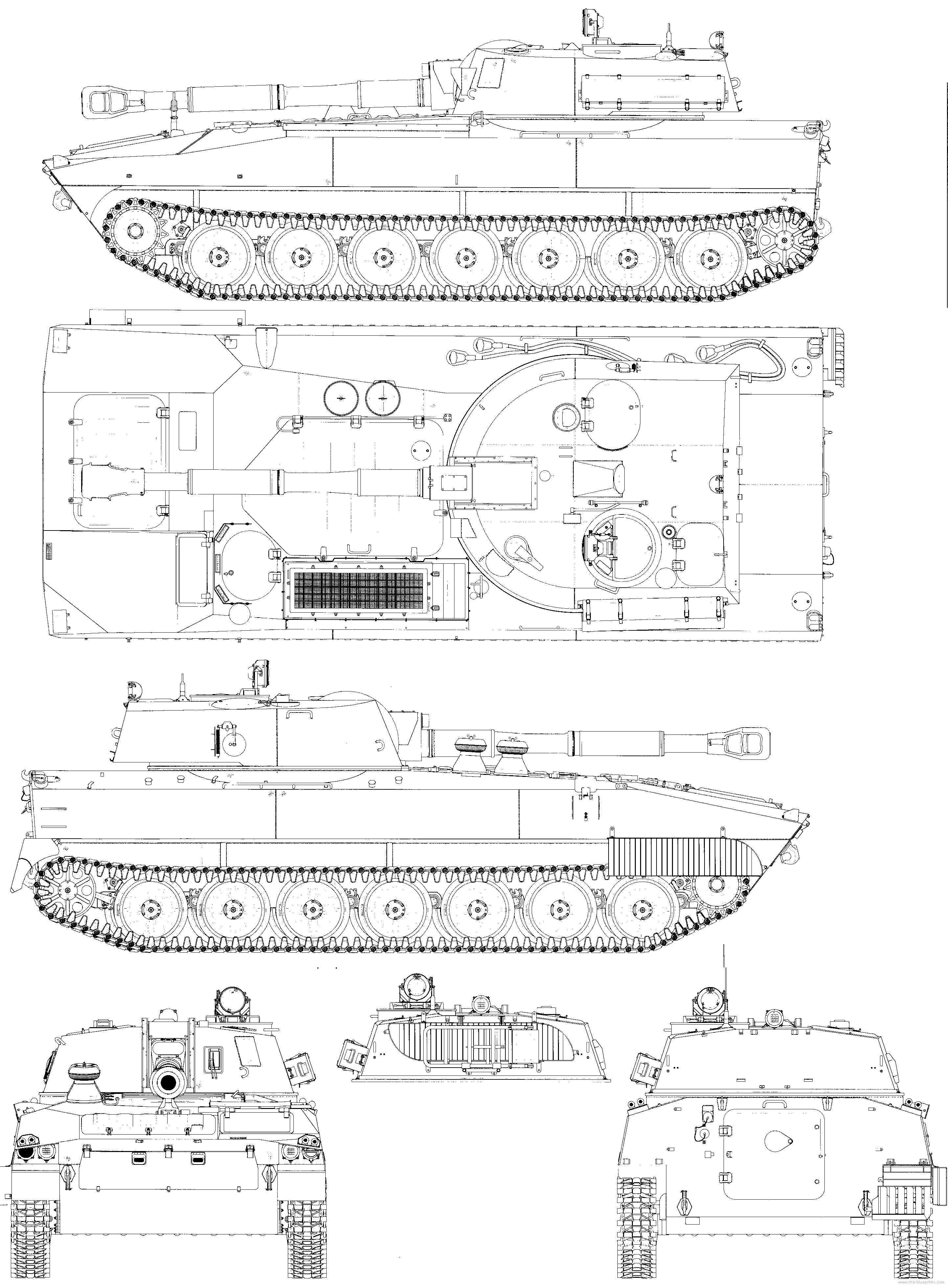
The 2S1 shares a lot of similarities with other vehicles using the same chassis, the MT-LBu is apparented to the MT-LB which itself shares components with the PT-76 amphibious tank. The hull is low and prismatic, with a front-middle-mounted engine and rear turret like often in SPGs. The nose is well-sloped to gain the advantage of sloped armour, only 20 mm thick. There is a well-pronounced upper glacis over around 1/3 of the hull's lenght, followed by a flat section, still with sloped sides. There is a two-man turret, not very roomy due to the size taken by the howitzer itself. The rear is flat, as are the sides, and the turret roof. The latter however had a rounded face. The gunner had a folding right side simple hatch, opening forward to protect the user as customary, and the commander was on the left, with a small cupola with three forward periscopes and central IR vision block. There was also a loader roof hach behind it.
The roof also had two projector, one facing the commander cupola and another at the turret back. There was a radio in the turret ad antenna located at the left side, in front of the aft hatch, a pistol port opposite for the gunner. Optics for the main gun were located at the left. The driver sat at the front, foward of the engine and transmission, and had its own rear-folding hatch with three periscopes (central IR one) and a glacis, small hatch in case the vehicle was toppled over. The transmission could be accessed by a large front hatch on the forward glacis and the engine itself by a large hatch on the central section, just in front of the turret. This necessitated to get the turret fully reverse in order to lift the heavy hatch, hinged to the right. Exhausts were located left. Access to oil and fuel were at the right as well as the two snorkel-lie air admission of the engine, when swimming. The 2S1 carried extra storage bins, notably one large on the turret side wall, left. The was also an engine and transmission access hatch on the downwards slope of the nose, and a back turret hatch opening left on the back plate to load ammunitions. The flat turret back had attachement points and straps to carry two front-mounted mud guards. They were rarely used.
Mobility
The 2S1 is propelled by YaMZ-238N diesel which developed 220 kW (300 hp). This power is passed to the gound via front drive sprockets and six stamped standard roadwheels plus rear idlers, on torsion bars, up to 60 kph on flat, 30 kph off-road and 4.5 kph when swimming. The 2S1 is fully amphibious with very little preparation, as it can swim its way propelled by its tracks (which are standard, but relatively narrow). A variety of track widths were available to allow the 2S1 to operate in snow or swamp conditions if needed.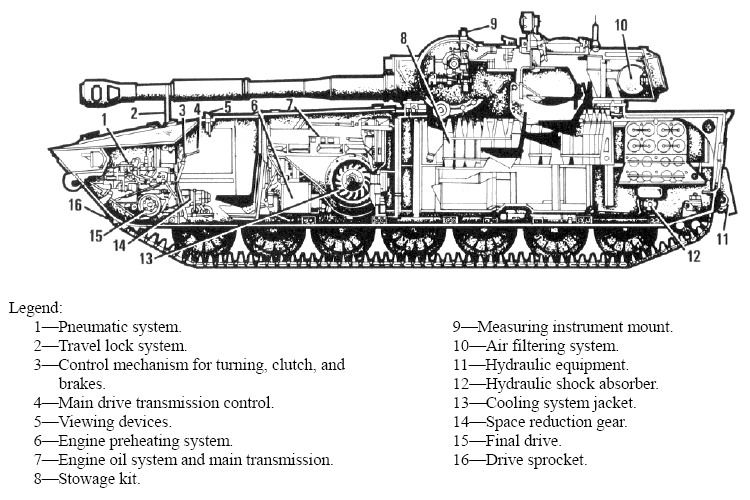
Cutout of the vehicle - src inetres.com
Armament

Soviet 122mm Howitzer 2A18 (D30) in towed configuration. This ubiquitous howitzer was and remains perhaps the most popular in the world. Designed by F.F. Petrov in the 1950s to replaced WW2 generation howuitzers in service, it was manufacturer at the PJSC Plant N°9 from 1960 and production never stopped, 60 years after. It was perhaps one of the greatest export success of USSR (ans Russia today), with the T54 and the AK-74. Figures as high as 60,000 howitzers has been given for total production, but since it was also dine under licence it's probably well above 100,000.
The D-30 mass is 3.21 tonnes, 5.4 complete with trailer, for a barrel lenght of 4.66 m. It fired a 122 x 447mm .R with separate loading charge and the 122 mm was the equivalent of 4.8 inches. The breech was semi-automatic with a vertical sliding-wedge and the recoil was hydro-pneumatic. Its carriage was tripod, sitting low, with the wheels transferred higher up, acting as extra protection of the gun. With its mount, it can elevation −7° to 70° on a 360° traverse. Rate of fire was 10–12 rpm, 5–6 rpm sustained. Effective range was 15.4 km (9.6 mi) and up to 21.9 km (13.6 mi) with with rocket-assisted projectile.
The 2S1 of course carried a heavily modified of this version. The muzzle brake was reworked, double-baffle, and it had a power rammer, and a massive fume extractor was built-in on the barrel, but it had however of course many similarities, like the separate loading, with a cased charge and same breech, elevation was the same, as travers with the turret. Rate of fire however was much lower, 5 rpm and just 1-2 rpm sustained. Its muzzle velocity was 680 m/s (2,200 ft/s) and maximum firing range slightly less, with conventional shell 15.3 km (9.5 mi) but the same with extended one 21.9 km (13.6 mi).

The biggest difference was the sheer diversity of shells used, allowing better flexibility for a vehicle of this class: The standards models were the HE (high explosive) model, but it could fire also the HE/RAP, leaflet, and armor-piercing HE, even a flechette (APFSDS) or chemical rounds. No statistics is available on penetration values of the flechette type, but doubling the figure of the basis velocity gives 1300 m/s which is below the low average (1400 m/s) compared to 1900 m/s for flechettes fired from conventional main battle tanks 120 mm guns. This is still way above the muzzle velocity of an AK-74 bullet, 900 m/s and therefore the kinetic energy is still enough to knock out most tanks. So far, no use of flechettes, therefore any anti-tank role has been reported. A few of these rounds could be stored "just in case" these rear vehicles would come in contact with tanks. The howitzer is shorter than the field gun version, its muzzle brake indeed is around 30 cm short of the nose of the vehicle, avoiding catching obstacles on its way; Despite of this, the turret is small enough not to ovehang the back plate, it's even 70 cm short of it. This allows the weight of the turret and gun to "spread" over the chassis.
There is no known secondary armament, either heavy or light machine gun onboard the 2S1. No photo ever shown MGs although some had oc conversions in the field by some users like Isis or Syrian rebels and othr insurgents, but no photo or footage were found to back this up. Of course the crew had access to personal weapons, pistols and possibly a short stock AK-74.
Protection
Being a rear line vehicle, relatively fast, the 2S1 was supposed to run out of countr-battery fire; Its protection was therefore limited to STANAG 2, protection against heavy machine gun fire and shrapnells, 20 mm of armour plating overall (turret face and sides, hull) although artificially augmented by slopes; The crew is also NBC protectied collectively thanks to a lining. The general shape and size of the vehicle is also consistent with Soviet practice as contrasted with the main NATO SPG, the M109. Its low silhouette allowed it a better chance of not be spotted and survival on the battlefield. But it is cramped and rough as well for the crew. No smoke projectors are known to be used on the vehicle at least on standard versions.Production & variants

Command vehicle based on the 2S1 chassis
The main production in USSR for this vehicle started in 1971 at Kharkiv. Figures are ellusive due to later conversions, exports, and production in the Warsaw pact, and nowodays in other countries as well.
USSR/Russia
2S34 Hosta – Modernisation of the 2S1 with the 122 mm 2A31 gun replaced by the 120 mm 2A80-1 gun-mortar. Further improvements include a new Malakhit fire control system, a battlefield observation system and the ability to fire the Kitolov-2M guided ammunition. One unit, the 21st Mechanized Brigade in Totskoye is currently being equipped with the system.2S15 Norov – A prototype tank destroyer equipped with a radar-based fire control system and a 100 mm gun.
Ukrainian Kevlar-E – Infantry fighting vehicle based on the 2S1 platform, equipped with Shturm remote weapon station and room for 6 passengers in addition to the 3 crew. The original 300 horsepower V8 diesel engine has been replaced with 420 horsepower diesel engine, produced by Caterpillar, Cummins or Deutz, increasing the maximum road speed to 70 km/h. Additionally, the vehicle is amphibious, includes air conditioning, a fire detection and suppression system, an NBC system, navigation system and night-vision equipment. The variant was first introduced in April 2018.
Poland
2S1 produced by Huta Stalowa Wola as 2S1 Goździk.-2S1M Goździk with special amphibious kit that increases the vehicle's amphibious capabilities.
-2S1T Goździk with TOPAZ digital fire control system (WB electronics); The system consists of a FONET-IP digital intercom system, new digital radio, military GPS receiver, military computer and dedicated software. The same system is used on other Polish Armed Forces artillery systems like the AHS Krab, Dana-T and WR-40 Langusta.
Romania

Romanian Model 89
Model 89 Romanian variant that uses a modified version of the hull of the MLI-84.
Iran
Raad-1 ('thunder') Iranian variant based on the hull of the Boragh APC.Myanmar 2s1u
March 2019 Ukrainian-delivered vehicles from a locally-built plant to manufacture both APCs and self-propelled howitzers. The first are BTR-4Us, the second the Ukrainian variant 2S1Us.Exports and Combat use
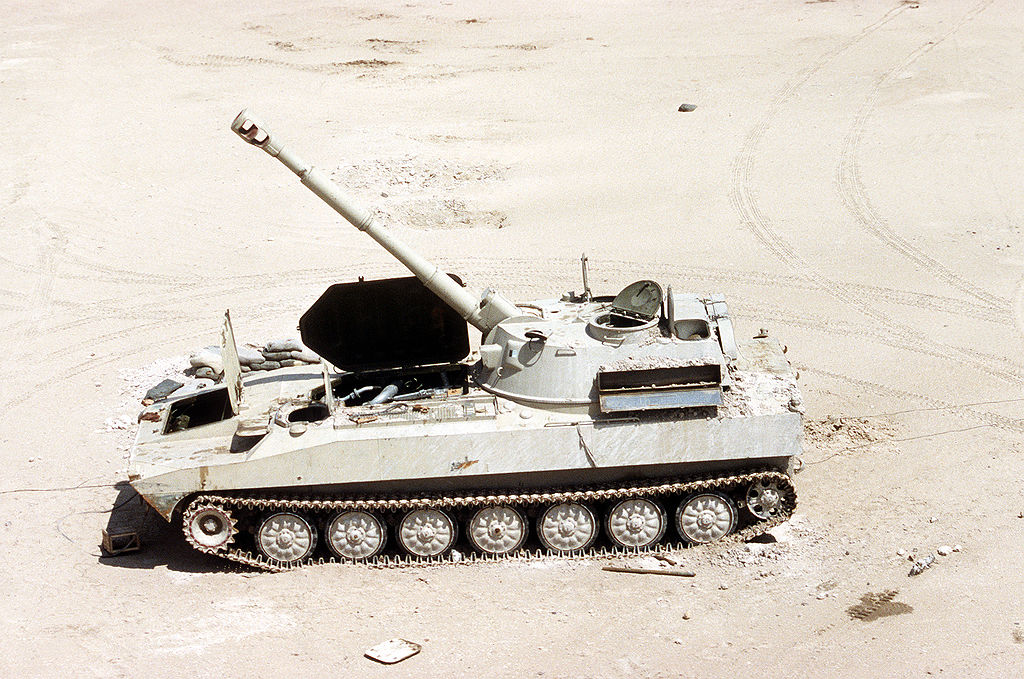
Iraqi M1974
Since 1972, the 2S1 was in action in the following: Soviet–Afghan War, Iran–Iraq War, Gulf War, War in Abkhazia (1992–1993), Yugoslav Wars, Kosovo War, First Chechen War, Second Chechen War, 2002-2014 Iraq War, 2008 South Ossetia War, Russo-Georgian War, First and second Libyan Civil Wars, Syrian Civil War and the War in Donbass. This is certaonly not over. The vehicle has no major flow and the D-30 howitzr ammunitions are still quite common. Also, commonality with many other vehicles helps. The 2S1 has been used in the following countries: Algeria (145 in service), Angola (?), Armenia (20), Azerbaijan (81 2S1 and UR-77), Bosnia and Herzegovina (5), Belarus (246), Bulgaria (506, also derived into the BMP-23 IFV), Cuba (?), Croatia (9 now added to 15 Panzerhaubitze 2000), Czechoslovakia and later the Czech Republic (400 ?), Eritrea (20), East Germany (discarded 1990), Ethiopia (?), Finland (72, known as 122 PsH 74), Hungary (144 Phased out in 2004), Georgia (48), India – 110 (replacement), Iran (? and Raad vehicles), Iraq (approx 200), Kazakhstan (10), Libya (approx. 100), Moldova (?), Romania (48 reserve since 2005 and model 89), Poland (324 currently replaced by SMK Rak and AHS Krab), Russia (622 and many more in reserve), Serbia (72), Slovakia (49), Slovenia (8 in reserve), South Ossetia (?), Syria (400), Transnistria, Turkmenista, Ukraine (638, some modernized as 2S1U), Uruguay (6), Uzbekistan, Vietnam, Yemen and the Islamic State, also unknown numbers.
2S7 Pion specifications | |
| Dimensions | 10.5 x 3.38 x 3m (34'5'' x 11'1'' x 10'1'' ft) |
| Total weight, battle ready | 46.5 tons |
| Crew | 7 (driver, commander, 2 gunner, 2 loader, radio) |
| Propulsion | V-46-I V12 turbocharged diesel 840 hp |
| Suspension | Torsion bars |
| Speed (road) | 50 km/h (31 mph) |
| Range | 650 km (400 mi) |
| Armament | 203 mm (8 in) howitzer |
| Armor | 10 mm frontal arc (0.39 in) |
| Total production | 500+ in 1976-1990 |
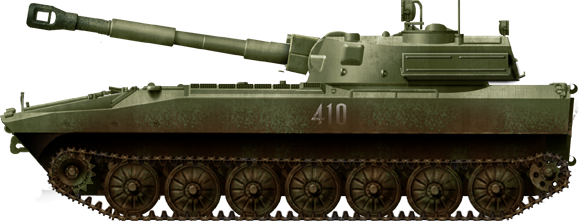
Soviet 2S1 '410' in the late 1970s
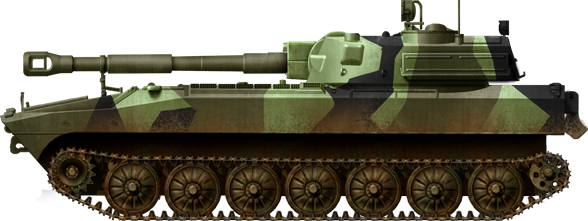
Finnish 2S1 in the 1990s
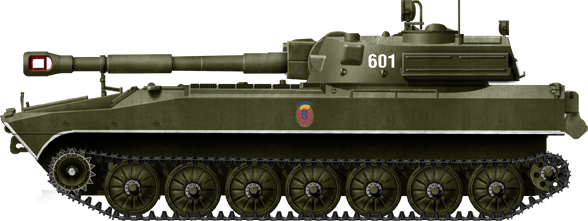
Soviet 2s1 in a parade in Kiev
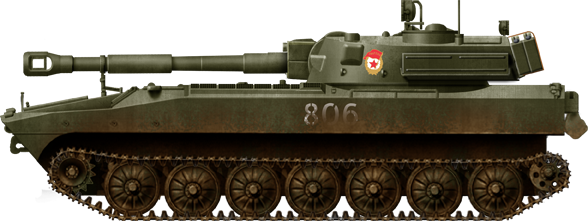
Soviet 2S1 of a red guards unit
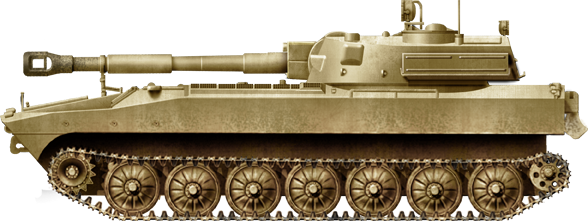
Iraqi 2S1 in 1990 - desert storm
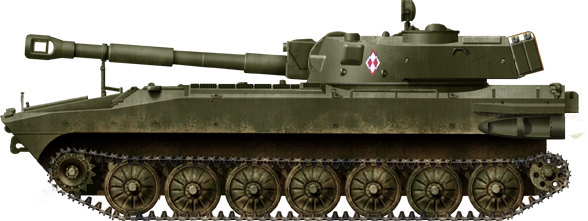
Polish 2S1 Gvodzik
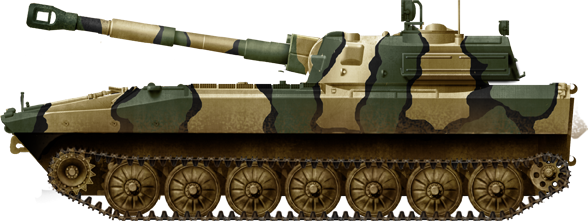
Russian 2S1 in the 1990s
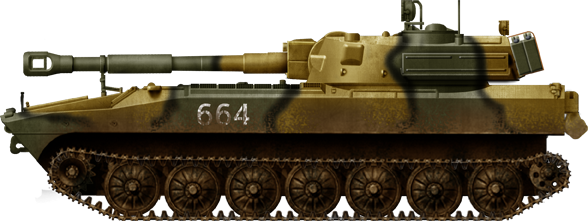
Russian modernised 2S1M in the 2000s

Cold War Tanks


































Cold war tanks posters

Cold War Main Battle Tanks

Cold War Soviet Army

